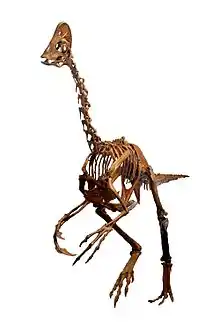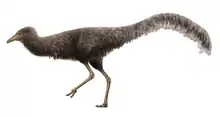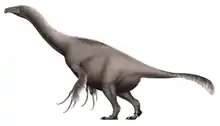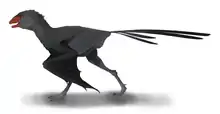Anzu wyliei
Anzu (named for Anzû, a bird-like daemon in Ancient Mesopotamian religion) is a genus of caenagnathine dinosaur from the Late Cretaceous (66 million years ago) Hell Creek Formation of North Dakota and South Dakota, United States. The type species is Anzu wyliei.
| Anzu | |
|---|---|
 | |
| Reconstructed skeleton, Carnegie Museum of Natural History | |
| Scientific classification | |
| Kingdom: | Animalia |
| Phylum: | Chordata |
| Clade: | Dinosauria |
| Clade: | Saurischia |
| Clade: | Theropoda |
| Family: | †Caenagnathidae |
| Subfamily: | †Caenagnathinae |
| Genus: | †Anzu Lamanna et al., 2014 |
| Type species | |
| Anzu wyliei Lamanna et al., 2014 | |
It was named one of the "Top 10 New Species" for new species discovered in 2014 by the International Institute for Species Exploration in 2015.[1][2]
Description

Anzu wyliei is characterized by a toothless beak, a prominent crest, long arms ending in slender, relatively straight claws, long powerful legs with slender toes, and a relatively short tail. Anzu measured about 3 metres (9.8 ft) to 3.5 metres (11 ft) long, up to 1.5 metres (4.9 ft) tall at the hips and 200 kilograms (440 lb) to 300 kilograms (660 lb) in weight, and was the largest North American oviraptorosaur,[3] though the Mongolian genus Gigantoraptor was larger than Anzu.
When the type specimen of Anzu was described, several autapomorphies (derived traits unique to a genus) were established. There is a high crescent-like crest on the skull, formed by the upper branches of the praemaxillae. The occipital condyle is wider than the foramen magnum. The front part of the lower jaw, which is fused with its counterpart, has a prominent flange on its outer side. The retroarticular process, a prominent projection at the rear of the lower jaw, is elongated, about as long as the jaw joint surface. The lower end of the radius is divided into two rounded processes. The first phalanx of the second finger has a trough along the lower edge of its inner side. The front side of the astragalus (ankle bone) has a tubercle at the base of its ascending process.[3]
An additional four possible autapomorphies were identified in the referred specimens. The main body of the maxilla has no depression around the antorbital fenestra. The nasal branch of the maxilla is elongated and constructed like an inverted L. The branch of the jugal towards the quadratojugal is vertically deep. The same branch is forked at its rear end.[3]
History of discovery

Several large skeletons from the late Maastrichtian Hell Creek Formation of Montana and South Dakota were initially referred to as "cf. Chirostenotes",[4] though more recent studies concluded that they represent new species.[5]
In 1998 Fred Nuss of Nuss Fossils discovered the site containing the Holotype CM 7800. The first two partial skeletons of Anzu were discovered in 1998 by Fred Nuss Fossils on a private South Dakota ranch.[6] The two specimens weren't buried together – the skeletons rested about 330 feet apart with the second individual in a rock layer about 11 feet below the first – but, once prepped by the commercial outfit Triebold Paleontology, it was clear that both represented the same dinosaur.[7] Both were mostly disarticulated and appeared to have been transported by a water current. A third referred specimen, fragmentary skeleton MRF 319, studied by Tyler Lyson of the National Museum of Natural History, was discovered by Scott Haire, who spotted the bones at his uncle's ranch at Marmarth, North Dakota. A rear lower jaw fragment, FMNH PR 2296, was also referred.[3][8]
These four fossils found at Hell Creek together make up a fairly complete skeleton of Anzu wyliei, comprising about 75 to 80 per cent of the whole skeleton.[8] Three researchers, Emma Schachner of the University of Utah, Matthew Lamanna of the Carnegie Museum of Natural History and Tyler Lyson of the Smithsonian in Washington realized in 2006 that they each had partial skeletons of the same species and began collaborating to study it, assisted by Hans-Dieter Sues, a paleontologist at the National Museum of Natural History of the Smithsonian Institution in Washington.[8] The main fossils are being held at the Carnegie Museum of Natural History in Pittsburgh.[9]

The genus is notable as the first well-preserved example of a North American oviraptorosaur. According to Sues, "for almost a hundred years, the presence of oviraptorosaurs in North America was only known from a few bits of skeleton, and the details of their appearance and biology remained a mystery. With the discovery of A. wyliei, we finally have the fossil evidence to show what this species looked like and how it is related to other dinosaurs."[9]
The creature's appearance – "big crests on their skulls, a beak, no teeth, and a very bird-like skeleton"[9] – and its discovery in the Hell Creek Formation led to it being jokingly nicknamed the "chicken from hell". Matthew Lamanna, who devised the species' name, originally wanted to use a Latin or Greek version of "chicken from hell". However, he found that this nickname does not translate well in those languages, so he eventually settled on evoking and using the name of the bird-like daemon Anzu from the mythology of ancient Sumer,[10] which itself roughly translates to "heavenly eagle".[11] The specific name, wyliei, honors Wylie J. Tuttle, the grandson of one of the museum's donors, Lee B. Foster.[3]
Phylogeny

Anzu was placed in the Oviraptorosauria, as a member of the Caenagnathidae. A cladistic analysis showed it was a possible sister species of Caenagnathus.[3]
| Caenagnathoidea |
| |||||||||||||||||||||||||||||||||||||||||||||
It had been expected that oviraptorosaurs would be found in North America, as well as the documented specimens in Asia, as the two continents had a land connection during the Cretaceous, but the discovery of Anzu wyliei indicates that North American oviraptorosaurs were related more closely to each other than to their counterparts in Asia.[12]
Paleobiology

Anzu was probably an omnivore or herbivore, although the beak is not as heavily constructed as in the Asian Oviraptoridae.[3] Other differences from its Asian cousins include size – the Asian Oviraptoridae were smaller – as well as thicker legs and different lower jaws.[8]
The fossils of Anzu wyliei were found in mudstone rock that had once been part of ancient floodplains. This indicates that the species likely had a lifestyle significantly different from its Asian counterparts, which lived in arid or semi-arid conditions.[12] Its lifestyle, according to Stephen Brusatte of the University of Edinburgh, was that of "a fast-running, ecological generalist that didn't quite fit the usual moulds of meat-eating or plant-eating dinosaur."[9] Its jaw morphology suggests that it could eat a variety of food items, including vegetation, small animals, and possibly eggs.[3]

While a number of its features were similar to those of modern birds, it was not an avian dinosaur and its line died out in the Cretaceous–Paleogene extinction event 66 million years ago, along with all the rest of the non-avian dinosaurs. Its bird-like features are instead an example of convergent evolution. Matthew Lamanna comments that "it would have had a lot of birdy behaviors. When people think of a dinosaur, they think of something like a T. rex or a brontosaurus, and when they think of a bird, they think of something like a sparrow or a chicken. This animal, Anzu, has a mosaic of features of both of those groups, and so it basically provides a really nice link in the evolutionary chain."[13]
The purpose of Anzu's large crest is unclear; Sues notes that it "is very large and made of paper-thin bone, so it was not able to take much stress. All oviraptosaurs have this crest but it is certainly the largest in A. wyliei. The most likely function is for display, showing off to members of your own species. The Australian cassowary has a similar crest which is thought to be used to attract mates, so it is possible that A. wyliei could have used its crest in a similar fashion."[12] The fossils showed evidence of injuries, including a healed broken rib and an arthritic toe that was probably the result of a tendon being ripped away from the bone (an avulsion fracture). It is not known whether this indicates that the animals fought each other, or were injured by predators.[9]
See also
References
- "The ESF Top 10 New Species for 2015". State University of New York College of Environmental Science and Forestry. Retrieved 13 November 2015.
- Berenson, Tessa (21 May 2015). "These Are the Top 10 New Species Discovered Last Year". Time. Retrieved 13 November 2015.
- Lamanna, M. C.; Sues, H. D.; Schachner, E. R.; Lyson, T. R. (2014). "A New Large-Bodied Oviraptorosaurian Theropod Dinosaur from the Latest Cretaceous of Western North America". PLoS ONE. 9 (3): e92022. doi:10.1371/journal.pone.0092022. PMC 3960162. PMID 24647078.
- Varricchio, D. J. (2001). Late Cretaceous Oviraptorosaur (Theropoda) dinosaurs from Montana. Mesozoic Vertebrate Life. D. H. Tanke and K. Carpenter. Bloomington, Indiana University Press: 42–57.
- Robert M. Sullivan, Steven E. Jasinski and Mark P.A. Van Tomme (2011). "A new caenagnathid Ojoraptorsaurus boerei, n. gen., n. sp. (Dinosauria, Oviraptorosauria), from the Upper Ojo Alamo Formation (Naashoibito Member), San Juan Basin, New Mexico" (PDF). Fossil Record 3. New Mexico Museum of Natural History and Science Bulletin. 53: 418–428.
- Triebold and Nuss (2000). "Initial report of a new North American oviraptor". Graves Museum of Archaeology and Natural History, Publications in Paleontology. 2.
- Stein, Walter (2001). So You Want to Dig Dinosaurs?. Woodland Park, CO: Dragon's Claw Press. p. 260. ISBN 0971620601. Retrieved 8 January 2015.
- Fawcett, Kirstin (March 19, 2014). "Scientists Discover a Large and Feathered Dinosaur that Once Roamed North America". Smithsonianmag.com. Retrieved March 20, 2014.
- Sample, Ian (March 19, 2014). "Dinosaur dubbed 'chicken from hell' was armed and dangerous". The Guardian. Retrieved March 20, 2014.
- Ritter, Malcolm (March 20, 2014). "'Chicken from hell' dinosaur gets a proper name". Associated Press. Retrieved March 20, 2014.
- Alster, B. (1991). Contributions to the Sumerian lexicon. Revue d'Assyriologie et d'archéologie orientale, 85(1): 1–11.
- "One Scary Chicken—New species of large, feathered dinosaur discovered". Smithsonian Science. March 19, 2014. Retrieved March 20, 2014.
- Achenbach, Joel (March 19, 2014). "New dinosaur called the Chicken From Hell". The Washington Post. Retrieved March 20, 2014.






.png.webp)



.jpg.webp)






